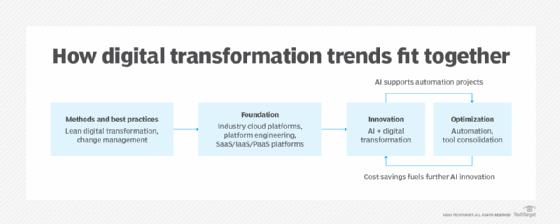
Getty Images/iStockphoto
Beyond digital transformation hype: What CIOs really think
For many IT leaders, keeping up with tech trends that improve company performance is table stakes. Learn about the realities of digital transformation beyond the hype.
Today's CIOs and IT leaders are making changes in their organization's tech and digital transformation strategies.
But the reality looks different than what media hype says, according to internal Andover Intel research, which surveyed more than 200 CIOs and senior tech planners.
Trends are changing -- including the increasing prominence of AI, cloud repatriation, or the movement of data and apps away from the cloud; the heightened use of virtual private networks (VPNs); and the continued emphasis on modernizing apps -- as CIOs decide what could support a company's business requirements.
Here's how CIOs and IT leaders think beyond the digital transformation hype to drive positive changes in their organizations.
Where the enterprise is adopting AI
Is AI sweeping the enterprise? The answer is nuanced.
Many CIOs are aware of line departments driving the great majority of AI trials. Moreover, many line departments are pursuing these trials without a formal AI adoption project in place. In other words, the CIO is not supporting software development or accumulating capital expenses.
Generative AI is the most widely known form of AI outside the IT organization, is easily accessible in an as-a-service form, and lets users explore the tool's potential without the confines of a formal software deployment.
Only about a quarter of CIOs believe their companies are committed to AI in production. But the potential for its widespread adoption is promising.
Chatbots in some form make up over 85% of actual AI projects, according to the same internal research. These AI projects have a formal, approved budget. Many of these chatbot projects focus on providing customer support.
The remainder of targeted AI implementations is a combination of specialty IT or network vendor AI tools, such as network monitoring systems or predictive maintenance software, for operations support and a small number of enterprise-hosted AI applications for business analysis.
Line departments are driving broader AI use via free or included tools that assist workers with email and document creation.
Since the CIO isn't directly involved in these uses and there's no capital project with CFO review, it will be unclear whether applying any of these tools generates significant business benefits.
There's no assurance that any free or integrated model of AI will be available in the future. There is also no guarantee that if AI providers set a price that offers a reasonable ROI, user benefits will justify paying that price.
Ultimately, if you offer free access to a new technology, there will always be users who take advantage of it. Moreover, it remains to be seen if there's a better use case for AI adoption in the enterprise.

Why skepticism shrouds cloud repatriation
You might think people are pulling work from the cloud in droves. That's not so. But that doesn't mean they're satisfied with their cloud decisions, according to internal research.
Over 50% of enterprises using cloud reported to Andover Intel that they've made some significant errors in their cloud assessment and development.
Only 3% indicated they repatriated apps since January 2023, meaning they moved them back from the cloud to the data center, according to the same internal research. But that figure is twice what it was in the previous year.
A third of enterprises said they had to make major changes to some of their cloud apps, and it was almost always to reduce cloud costs, according to the same internal research.
Repatriation is a decisively major change. What matters is why CIOs and IT leaders think they've made mistakes that drove up their cloud costs.
The problem is a combination of hype and the difficulties that new cloud prospects have getting the right people to lead cloud projects, according to the same internal research.
Experienced software architects with knowledge of cloud features, costs and the relationship between the two are difficult to find. Most software architects want to work for vendors, cloud providers and startups. Junior architects often need help identifying the optimum structure for cloud apps.
Less than 20% of CIOs say they've considered third-party resources to assist in cloud planning and development, according to the same internal research.
Many CIOs that abandoned pursuing third-party resources cited costs as the primary reason for not following through. The number of third-party projects completed and audited for results is likely too small for statistical confidence. Still, it appears that third-party resources did no better than in-house planning and development.
How the overhaul of VPN serves the enterprise
VPNs have been around a long time. Like many long-lived technical concepts, they continue to evolve. This evolution has generated two primary VPN models. The first is the Multiprotocol Label Switching (MPLS) VPN offered as a service by network operators worldwide. The second is an overlay VPN -- a type of VPN that runs on top of another network -- used by both businesses and consumers to enhance connection privacy and security when used with the Internet.
What's happening now in the VPN market is a fusion of these models and fusion with the cloud as well as a potentially critical new access option.
Many CIOs look to MPLS VPNs for their reliability and because they can negotiate service-level agreements to assure quality of service.
What these same CIOs don't like is their cost, which they say is more than five times that of an internet connection of similar speed. Moreover, MPLS VPNs aren't often available in many remote locations, particularly outside major markets like the U.S. and EU.
Software-defined wide area networking (SD-WAN) technology emerged to combine major-site MPLS VPNs with internet overlay VPNs to form a unified VPN. The tech can serve locations where MPLS VPNs are too expensive or unavailable. It can potentially even replace MPLS VPNs in some or all locations.
But less than 5% of CIOs say they've replaced MPLS VPNs, according to internal research.
That might be changing because SD-WAN is increasingly available as a cloud component, either by itself or as part of a secure access service edge model. SASE is a network architecture that combines WAN capabilities with functions such as cloud access security brokers and firewall-as-a-service.
This functionality lets SD-WAN take workflows from the internet directly to the cloud and then onto the corporate VPN. If workers in any remote location -- whether at home, a small branch site or even a current MPLS VPN site -- use the internet and cloud to access apps, they won't need to use a VPN at the point of access.
One-fifth of CIOs say they're evaluating this cloud-first VPN option, according to internal research.
Fixed wireless access (FWA) is also affecting many CIO's plans. Usually offered as a use case of 5G mobile technology, FWA could deliver hundreds of megabits of bandwidth over the air. If the tech becomes widely available, it could make any of the cloud VPN options both faster and less expensive.
So far, less than 10% of CIOs are actively exploring FWA. But the number has doubled since 2022, according to the same internal research.
What happens when hype overlaps
One of the more abstract points CIOs have made in 2024 might turn out to be one of the most profound in the long term.
In 2022, digital transformation, application modernization and cloud computing were handled as three largely independent CIO initiatives. By early 2024, a third of CIOs were wondering if the three IT initiatives belong together. Almost half of that group believed that they did, according to internal research.
Many CIOs noted that moving an app to the cloud cannot be viewed as simply a redeployment. Modifications to code are almost always critical in getting the right balance between the cloud's scalability benefits and the data center's compliance and hosting cost advantages.
These CIOs also say that the best business cases for transformation also include some use of the cloud. Therefore, consideration of the same modernization techniques as cloud adoption overall would be beneficial.
Applying different names to IT activities that can potentially be drivers of change when they likely involve similar steps from IT staff, comparable involvement from line departments and similar technology choices simply generates confusion and greater risk.
When contemplating change within the organization, best practices say companies should explore all proposed changes to optimize time, cost and outcome.
Tom Nolle is founder and principal analyst at Andover Intel, a consulting and analysis firm that looks at evolving technologies and applications first from the perspective of the buyer and the buyer's needs. By background, Nolle is a programmer, software architect, and manager of software and network products. He has provided consulting services and technology analysis for decades.







